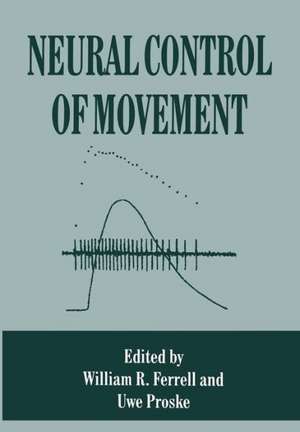Neural Control of Movement
Editat de W.R. Ferrell, Uwe Proskeen Limba Engleză Paperback – 21 dec 2011
Preț: 392.60 lei
Nou
Puncte Express: 589
Preț estimativ în valută:
75.15€ • 81.65$ • 63.16£
75.15€ • 81.65$ • 63.16£
Carte tipărită la comandă
Livrare economică 21 aprilie-05 mai
Preluare comenzi: 021 569.72.76
Specificații
ISBN-13: 9781461358183
ISBN-10: 1461358183
Pagini: 328
Ilustrații: 326 p. 55 illus.
Dimensiuni: 170 x 244 x 17 mm
Greutate: 0.52 kg
Ediția:Softcover reprint of the original 1st ed. 1995
Editura: Springer Us
Colecția Springer
Locul publicării:New York, NY, United States
ISBN-10: 1461358183
Pagini: 328
Ilustrații: 326 p. 55 illus.
Dimensiuni: 170 x 244 x 17 mm
Greutate: 0.52 kg
Ediția:Softcover reprint of the original 1st ed. 1995
Editura: Springer Us
Colecția Springer
Locul publicării:New York, NY, United States
Public țintă
ResearchCuprins
Afferent Mechanisms.- Isolated muscle spindles, their motor innervation and central control.- Recent developments in the physiology of the mammalian muscle spindles.- The human muscle spindle and its fusimotor control.- Mechanisms underlying the excitation of muscle afferents by suxamethonium.- Quantitative aspects of the use of succinylcholine in the classification of muscle spindle afferents.- Tendon organ discharges and their central effects during muscle contractions.- Proprioception.- Muscle, cutaneous and joint receptors in kinaesthesia.- Contribution of joint afferents to proprioception and motor control.- Assessing accuracy of positioning joints and limbs.- The behaviour of cutaneous and joint afferents in the human hand during finger movements.- Limitations in the neural control of human thumb and finger flexors.- Reflexes.- Fusimotor reflexes from joint and cutaneous afferents.- Reflex performance of the chronically isolated human spinal cord.- Enkephalinergic and monoaminergic control of segmental pathways from flexor reflex afferents (FRA).- Can the sympathetic nervous system activation contribute to “context-related” modulations of the stretch reflex?.- Classical conditioning of eyeblink in decerebrate cats and ferrets.- Locomotion.- Cellular bases of locomotor behaviour in lamprey: coordination and modulatory control of the spinal circuitry.- Reflex reversal in the walking systems of mammals and arthropods.- A locomotor-related “autogenetic” Ib excitation of hind-limb extensor muscles in thecat.- Modulation of stretch reflexes during behaviour.- A multiple-level approach to motor pattern generation.- The status of the premotor areas: evidence from PET scanning.- Development.- Organization of spinal locomotor networks and their afferent control inthe neonatal rat.- Dual control of central pattern generators: neonatal rat spinal cord in vitro.- Rhythmic activity patterns of motoneurones and interneurones in the embryonic chick spinal cord.- Postembryonic maturation of a spinal circuit controlling amphibian swimming behaviour.- Cerebellar Mechanisms.- The cerebellum as a predictive model of the motor system: a Smith predictor hypothesis.- Signalling properties of deep cerebellar nuclei neurones.- Visual input to the lateral cerebellum.- Inferior olive and the saccadic neural integrator.- Comparative Studies.- Presynaptic gain control in a locust proprioceptor.- Central and reflex recruitment of crayfish leg motoneurones.- Primitive role for GAB Aergic reticulospinal neurones in the control of locomotion.- Neuromodulation and motor pattern generation in the crustacean stomatogastric nervous system.- Mechanosensory signal processing: impact on and modulation by patterngenerating networks, exemplified in locust flight and walking.- Escape and swimming in goldfish: A model system for studying interactions between motor networks.






